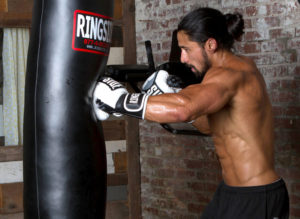
While so much of what makes a great boxer or MMA fighter is technique, speed, and mental toughness, it doesn’t hurt to have a powerful punch. No matter how the fight is going, it can turn decidedly in your favor if you can land one devastating punch.
If you’re not blessed with innate punching power, though, don’t worry. Making these nine exercises part of your boxing training program can help you improve in a big way.
Medicine Ball Throw
The key to packing more of a punch is training the explosiveness of your arms and increasing the power generated from your punching muscle fibers. Both of these techniques can help achieve that:
- Lie flat on your back and throw a heavy medicine ball as high as you can, pushing forward from the chest. Catch the ball with both hands and repeat until fatigue sets in.
- While standing upright in your boxing stance, take a medium-weight medicine ball into the palm of one hand and push forward as hard as you can. You can either throw the ball against the wall or have a partner catch it and throw back to you. You should do this as if you’re throwing a punch.
Plyometric Push-Ups
Increasing power and speed will allow you to make contact that can stagger your opponent. Plyometric push-ups can aid power and speed by training arm, shoulder, and pectoral strength–all parts of the body that influence punching power. Read on for a brief description of how they are performed.
- In the standard push-up position, dip down as you normally would but, as you rise, explode up so that your hands lift off the ground.
- To get peak results, ensure your core and glutes remain tight throughout the act.
- A slight variation to the exercise involves clapping your hands in mid-air or against your chest after you push off the floor.
Work the Heavy Bag
The heavy bag is training staple for a reason, so throw on your bag gloves (boxing- or MMA-style, you will benefit in either sport) and get well-acquainted with the heavy bag.
In ten-second intervals, try to hit as hard as you can using any combination of straights, hooks, and uppercuts. Then, for 10-15 seconds, conduct an active rest time of light jabs and footwork before ramping it up for another 10 seconds. Carry these out for three-minute rounds, resting for about a minute in between sets.

Shadowboxing
Although it may not seem like it, shadowboxing is great for increasing punching power because it forces you to focus on technique and proper execution. The better your form is, the more efficiently you will deliver your punches. This means that more of the power you’ve developed in your muscles will wind up at the tip of your glove.
With the supervision of a trainer or boxing buddy, shadowbox in front of a mirror while paying close attention to technique and the way you throw punches. The bonus here is the exercise should also train defense, head movement, and footwork to make you a better all-around fighter. This is one of the reasons that Shadowboxing is a fundamental part of any boxing training program.
Squats with Medicine Ball
Whether you’re your training for boxing or MMA, rest assured that a majority of your punching power comes from your legs. Performing squats with a medicine ball will help give you a stronger base to work from.
Combine Squats and Lunges
Since full squats can add weight and force you up a weight class and lunges recreate movement patterns often used in the ring, combining split squats and lunges is a good option for efficient athletes.
Tub o’ Rice
Hand injuries are very common in boxing and MMA, so you need to put an emphasis on strengthening your fists. Start by getting a large tub of rice and digging your hands through it, fingertips first. You can also try punching through water or into sandbags to help strengthen your fists.
Rotate Your Torso
An underrated component to delivering impactful punches, especially later in fights when you start to tire, is rotating shoulders and torso as you deliver a hit. Work on creating that kind of torque by holding a medicine ball at chest level with both hands, straightening your arms and rotating your torso continuously from left to right.
Chin-Ups
Chin-ups are perfect for training your opposing (antagonist) muscles, so you’re not solely focusing on strengthening pecs, anterior deltoids, triceps, and other primary muscle groups used in punching. Get the most out of it by performing them with additional resistance as you go along.

